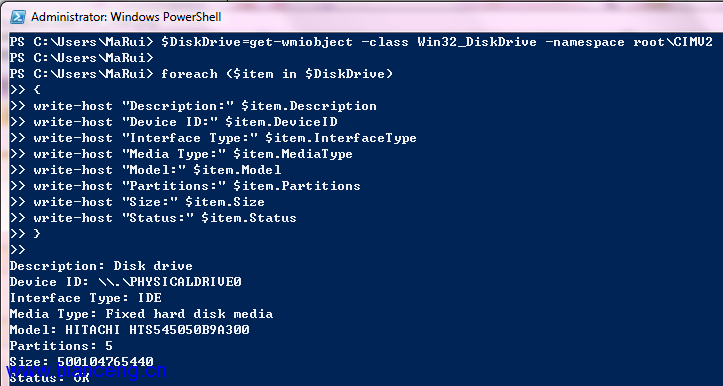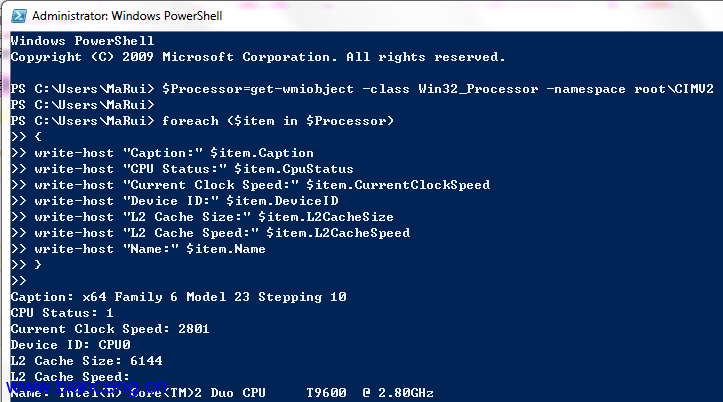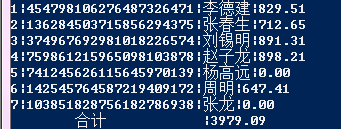PowerShell作為可編程性語言,擁有以下循環語句。
注:本節所要討論的內容的實質更多的偏向於程序設計方面,所以在此不做過多詳細講解,只針對PowerShell中的應用進行具體講解。
• for (初值;表達式;賦值語句) {代碼} 用變量值控制執行次數
• foreach (成員變量 in 數組) {代碼} 利用迭代執行代碼
• foreach-object 對一組輸入的每個對象執行運算
• while(表達式) {代碼} 表達式為真時循環執行代碼
• do {代碼} while(表達式) 類似於while,只是先執行代碼,再判斷表達式真假
• do {代碼} until(表達式) 執行代碼,直至表達式為假
循環語句在PowerShell中的應用
利用foreach查詢硬件信息
例一:
$DiskDrive=get-wmiobject -class Win32_DiskDrive -namespace root\CIMV2
foreach ($item in $DiskDrive)
{
write-host "Description:" $item.Description
write-host "Device ID:" $item.DeviceID
write-host "Interface Type:" $item.InterfaceType
write-host "Media Type:" $item.MediaType
write-host "Model:" $item.Model
write-host "Partitions:" $item.Partitions
write-host "Size:" $item.Size
write-host "Status:" $item.Status
}
運行結果:

例二:
$Processor=get-wmiobject -class Win32_Processor -namespace root\CIMV2
foreach ($item in $Processor)
{
write-host "Caption:" $item.Caption
write-host "CPU Status:" $item.CpuStatus
write-host "Current Clock Speed:" $item.CurrentClockSpeed
write-host "Device ID:" $item.DeviceId
write-host "L2 Cache Size:" $item.L2CacheSize
write-host "L2 Cache Speed:" $item.L2CacheSpeed
write-host "Name:" $item.Name
}
運行結果:

使用while監視進程狀態
notepad
While(get-process -name notepad | select -Property Responding){}
$time = get-date
Write-Host "The Notepad failed to respond on:$time"
在此例下,若進程notepad出現未響應,則會產生屏幕輸出。
使用do while表達:
notepad
do{}
While(get-process -name notepad | select -Property Responding)
$time = get-date
Write-Host "The Notepad failed to respond on:$time"
利用do until進行交互
do
{
"Quit Now? (Y/N)"
$input=Read-Host
}
until($input -eq "Y")
運行結果:

使用foreach-object進行格式化輸出
對下列數據進行操作,
D00454798106276487326471李德建829.51
Q00136284503715856294375張春生712.65
H00374967692981018226574劉錫明891.31
R00759861215965098103878趙子龍898.21
J00741245626115645970139楊高遠-13.21
K00142545764587219409172周明647.41
P00103851828756182786938張龍-27.51
使之輸出為以下所示格式:
1|454798106276487326471|李德建|829.51
2|136284503715856294375|張春生|712.65
3|374967692981018226574|劉錫明|891.31
4|759861215965098103878|趙子龍|898.21
5|741245626115645970139|楊高遠|0.00
6|142545764587219409172|周明|647.41
7|103851828756182786938|張龍|0.00
小計 |3979.09
使用foreach-object對每個數據成員使用正則表達式,最後格式化輸出即可:
${C:\test.txt} | `
foreach-object{$total=0;$id=1}`
{
[void]($_ -match '^.{3}(?<id>\d+)(?<name>[\p{IsCJKUnifiedIdeographs}]+)(?<salary>[\d.]*)');
$ofs = '|';
"$($id;$id++;$matches.id;$matches.name;'{0:f2}' -f [float]$matches.salary)";
$total += $matches.salary
}`
{"`t小計`t`t|$total"}
運行結果:

歡迎提出意見建議!
出處http://marui.blog.51cto.com/1034148/294113